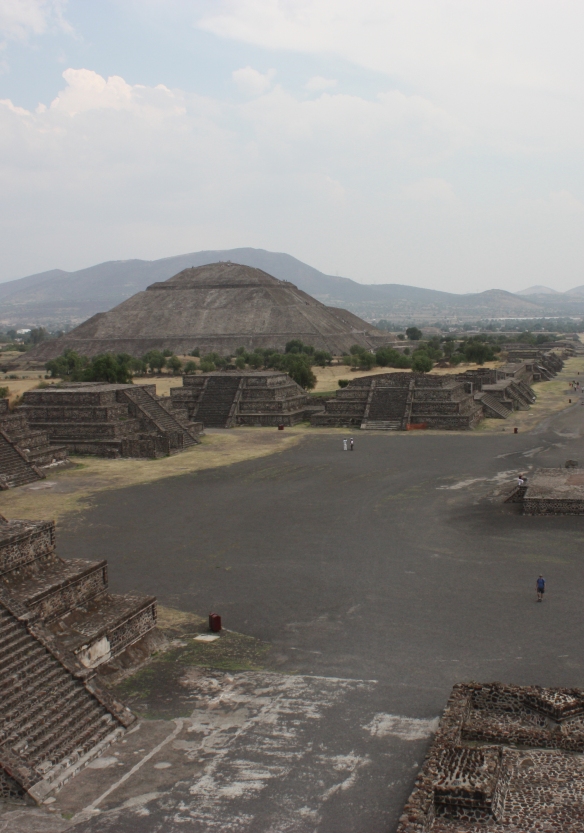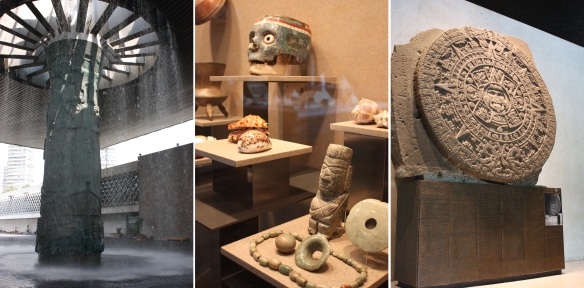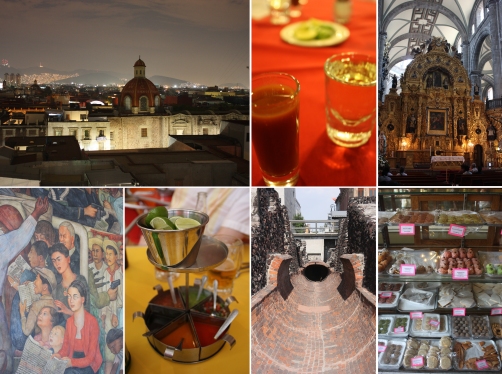I love Mexico – such amazingly warm, inviting and industrious people; simple, beautiful food; and an incredible history contrasted with such a broad spectrum of architecture and public spaces – from the organic hand-made structures sprawling out from every city, to the colonial beauties, to some of the most impressively tech-y and/or modern structures I’ve ever seen. In other words, there is a little bit of everything – and in no other place is this more apparent than in Mexico City itself. The third largest city in the world, it is a crazy mix-up of an exciting place where you can find anything, or anything can happen – having said that – it is no more dangerous than going to any other large city where it is always a good idea to be smart and aware of your surroundings. It always makes me a little sad that an entire country gets wiped off the radar of vacation goers just because of drug wars that are happening hundreds of miles away (smack dab next to our country, mind you) at the border towns (admittedly, Acapulco had some issues too – so definitely check the State Department warnings before heading anywhere in Mexico these days). But, hey, it meant we were among the few gringos wandering around in this impressive city on our recent trip there. I spent some time in Mexico City, aka Distrito Federal (or DF to the locals) a handful of years ago when I spent a quarter in Cuernavaca for a design build project. We would go in for a day or two at a time, devour a museum or historical or architectural significant site or building, and then be on our way back to our relatively quiet, lovely colonial town an hour or so outside of the city. This didn’t actually prepare me for what a full on immersion into the city might be like for 6 or more days – but we were really jonesing for an out of the country excursion where we could meet up with our DC-based buddies, Brian and Becky, but on a in-country budget – so we decided to try it.
We spent the first few nights in the Centro Historico, and wandered out from our hotel – nothing fancy, but great roof deck (above – top left), great breakfast, helpful staff and just a few paces to the Catedral Metropolitana, Palacio Nacional and Templo Mayor. The Catedral (top right) was begun in 1525, and has visible signs of every architectural stage since then – along with much evidence of sinking into the soft soil of the ancient lake bed. The Palace – the official building of the Mexican government – while impressive on its own, recedes in the presence of the expansive Diego Rivera murals on the central staircase, The Epic of the Mexican People (Kahlo’s cameo, bottom left) and the 9 Historical Murals on the second floor. And the Temple Mayor – the center of the ancient city of Tenochtitlan (ancient Mexico City), only uncovered in 1978 – is a powerful contrast to the surrounding Spanish colonial buildings, that no doubt were built with stones taken from this double pyramid structure.
While in the Centro, we had what was most likely our best Tacos al Pastor at El Huequito (bottom, second from left), yummy old-school Mexican sweets at Dulceria de Celaya (bottom, right), tamales and “Mexican Plates” at 100-year-old Cafe Tacuba. Sipping tasty tequillas and sangritas (top, middle) at the historic Bar La Opera was a highlight for sure, in a booth directly under the bullet hole from Pancho Villa – apparently shot while riding his horse through the room during the Mexican Revolution.
We spent our remaining 4 nights in the city at a wonderful bed and breakfast in the Condesa neighborhood, Casa Comtesse – owned by French expat, Tomas. He and his staff were great at helping us orchestrate our daily excursions, the breakfast were hearty and good, there were great spots to sit and take breaks, and the cost was totally reasonable. Condesa is a lovely, leafy neighborhood, with some hip restaurants, cafes and shops and central to many of the things we were interested in checking out throughout the city. I highly recommend it!
 Our first night there, we met up with the recently-turned local, George Nunes, a friend of Becky’s from her days with the Pacific NW Ballet. He was a wonderful addition to our group for several of our outings – and quite frankly we couldn’t have done Mexico City without him! Check out his travel writing here. He led us to Travazares Taberna that first night which was “favorite meal #1” – a lingering, small plates feast with good wine and good laughter among us and the attentive waitstaff in a small but rambling, rustic but artsy space (above, top left). Michoacán style ice cream and paletas (top center) are a must for pit stops on excursion filled days (shops can be found all over the city). “Favorite meal #2”, also directed to by George, was at El Bajio, in the Polanco neighborhood – a beautiful take on traditional Mexican foods of many regions (top right), but focused on the Veracruz origins of its owner, Carmen Titita. The empanadas and ceviche were especially lovely for me, while the fellas swore by the barbacoa tacos. THE best margaritas were had here, but they cost just as much, if not more than the food itself (just to forewarn as prices for drinks aren’t listed). A few other food highlights were the Pastelería Suiza (swiss bakery – bottom left – Parque España 7); the very difficult to locate, but fun-once-found mezcal bar, La Botica – so hipster we felt like we were actually in San Francisco, but the yummy cocktails and adjoining tamales snacks did us right; and last but not least, the caramel-filled churros of El Convento (being made, bottom right – Plaza del Carmen 4, San Angel neighborhood). I also want to take a second here to mention a great resource I found while researching – a food blogger and food tour guide based in DF – Lesley Tellez’s Mija Chronicles.
Our first night there, we met up with the recently-turned local, George Nunes, a friend of Becky’s from her days with the Pacific NW Ballet. He was a wonderful addition to our group for several of our outings – and quite frankly we couldn’t have done Mexico City without him! Check out his travel writing here. He led us to Travazares Taberna that first night which was “favorite meal #1” – a lingering, small plates feast with good wine and good laughter among us and the attentive waitstaff in a small but rambling, rustic but artsy space (above, top left). Michoacán style ice cream and paletas (top center) are a must for pit stops on excursion filled days (shops can be found all over the city). “Favorite meal #2”, also directed to by George, was at El Bajio, in the Polanco neighborhood – a beautiful take on traditional Mexican foods of many regions (top right), but focused on the Veracruz origins of its owner, Carmen Titita. The empanadas and ceviche were especially lovely for me, while the fellas swore by the barbacoa tacos. THE best margaritas were had here, but they cost just as much, if not more than the food itself (just to forewarn as prices for drinks aren’t listed). A few other food highlights were the Pastelería Suiza (swiss bakery – bottom left – Parque España 7); the very difficult to locate, but fun-once-found mezcal bar, La Botica – so hipster we felt like we were actually in San Francisco, but the yummy cocktails and adjoining tamales snacks did us right; and last but not least, the caramel-filled churros of El Convento (being made, bottom right – Plaza del Carmen 4, San Angel neighborhood). I also want to take a second here to mention a great resource I found while researching – a food blogger and food tour guide based in DF – Lesley Tellez’s Mija Chronicles.
 Our first excursion outside of the city was to the ancient site, Teotihuacan. Founded in 100 BC, the impressive pyramids and temples were the Mesoamerican cultural and commercial center in their day. A lot of mystery still surrounds the origins of this site, and its ultimate abandonment, but there is no doubt that it was the center of a fairly complex culture. I always find it fascinating that we hear so little about the cultures of Central America, that were going on at the same time as the Greek and Roman empires, and just as elaborate and complex… but I digress. A hike up the Pyramid of the Sun, and the Pyramid of the Moon are a must – as well as the Quetzalpapaloytl Palace (just figuring out how to say that word properly is half the fun!).
Our first excursion outside of the city was to the ancient site, Teotihuacan. Founded in 100 BC, the impressive pyramids and temples were the Mesoamerican cultural and commercial center in their day. A lot of mystery still surrounds the origins of this site, and its ultimate abandonment, but there is no doubt that it was the center of a fairly complex culture. I always find it fascinating that we hear so little about the cultures of Central America, that were going on at the same time as the Greek and Roman empires, and just as elaborate and complex… but I digress. A hike up the Pyramid of the Sun, and the Pyramid of the Moon are a must – as well as the Quetzalpapaloytl Palace (just figuring out how to say that word properly is half the fun!).
 As I mentioned earlier – architecturally, there is a little bit of everything to see in Mexico City. The climate, the materials and the culture come together to create some of the most simple, but beautiful structures, but there are also some incredibly high-tech moves to be found as well. Just walking around the Condesa neighborhood itself, we were constantly surprised by the modern infill projects (just one small example above, bottom left). But, the highlight for me again this trip was a visit to La Casa Luis Barragán – the home and studio of architect, Luis Barragán (no photos allowed, except for exterior – bottom right). I won’t archi-geek out on you too much, but it is an incredible place, a series of public and private, interior and exterior spaces with varying degrees of visibility to each other, all with amazing play of light and simple but powerful design moves. The home museum felt very personal, and is as he left it with all his artwork and relics – but we were most surprise to be within mere inches of his 1980 Pritzker Prize that just sits upon desk like he just received it. Switching gears to the more current architecture, we were also blown away by the Biblioteca Vasconcelos – a megalibrary designed by Alberto Kalach and finished in 2006 (top right – not doing it justice however). It’s massive scale is canyon-like, but rendered in steel stacks hanging over the central court. Most DF trips really aren’t complete without some Frida Kahlo and/or Diego Rivera visits – our only one this trip, outside of Rivera’s Palace murals, was a visit to the Studio Museum – his house and studio in the San Angel neighborhood (top left), designed by Juan O’Gorman in the late 1920’s. His north-facing, soaring work space will make any artist envious (only exterior shots could be taken here as well). Kahlo did live and work here as well (in the blue building, separated by a bridge from Rivera’s living and studio quarters), but her Casa Azul in the Coyoacan neighborhood is the more quintessentially Frida place to visit.
As I mentioned earlier – architecturally, there is a little bit of everything to see in Mexico City. The climate, the materials and the culture come together to create some of the most simple, but beautiful structures, but there are also some incredibly high-tech moves to be found as well. Just walking around the Condesa neighborhood itself, we were constantly surprised by the modern infill projects (just one small example above, bottom left). But, the highlight for me again this trip was a visit to La Casa Luis Barragán – the home and studio of architect, Luis Barragán (no photos allowed, except for exterior – bottom right). I won’t archi-geek out on you too much, but it is an incredible place, a series of public and private, interior and exterior spaces with varying degrees of visibility to each other, all with amazing play of light and simple but powerful design moves. The home museum felt very personal, and is as he left it with all his artwork and relics – but we were most surprise to be within mere inches of his 1980 Pritzker Prize that just sits upon desk like he just received it. Switching gears to the more current architecture, we were also blown away by the Biblioteca Vasconcelos – a megalibrary designed by Alberto Kalach and finished in 2006 (top right – not doing it justice however). It’s massive scale is canyon-like, but rendered in steel stacks hanging over the central court. Most DF trips really aren’t complete without some Frida Kahlo and/or Diego Rivera visits – our only one this trip, outside of Rivera’s Palace murals, was a visit to the Studio Museum – his house and studio in the San Angel neighborhood (top left), designed by Juan O’Gorman in the late 1920’s. His north-facing, soaring work space will make any artist envious (only exterior shots could be taken here as well). Kahlo did live and work here as well (in the blue building, separated by a bridge from Rivera’s living and studio quarters), but her Casa Azul in the Coyoacan neighborhood is the more quintessentially Frida place to visit.
 So, I will leave you with what is most likely my very favorite thing in DF – the Museo Nacional de Antropología – one of the best museums I’ve ever been too. I don’t really see myself as a huge anthropology fan, but something about the grand scale of the building’s architecture meshing so well with the grand scale of its subject matter is so fitting, and the displays are done so well, and are so digestible without being overwhelming. You literally need days to see everything here – and we only spent part of a day primarily soaking up the Aztec Room (with a few drive by’s in the Mayan and Olmec rooms) but if you are interested in history of any genre, I think you will find something to be fascinated with here. Taking a stroll in the main city park, Bosque de Chapultepec, is a lovely way to get to, or leave from the museum.
So, I will leave you with what is most likely my very favorite thing in DF – the Museo Nacional de Antropología – one of the best museums I’ve ever been too. I don’t really see myself as a huge anthropology fan, but something about the grand scale of the building’s architecture meshing so well with the grand scale of its subject matter is so fitting, and the displays are done so well, and are so digestible without being overwhelming. You literally need days to see everything here – and we only spent part of a day primarily soaking up the Aztec Room (with a few drive by’s in the Mayan and Olmec rooms) but if you are interested in history of any genre, I think you will find something to be fascinated with here. Taking a stroll in the main city park, Bosque de Chapultepec, is a lovely way to get to, or leave from the museum.
After all of that were in definite need of a slower pace and some down time on this vacation – stay tuned for elements of the Puerto Vallarta part of our trip!


